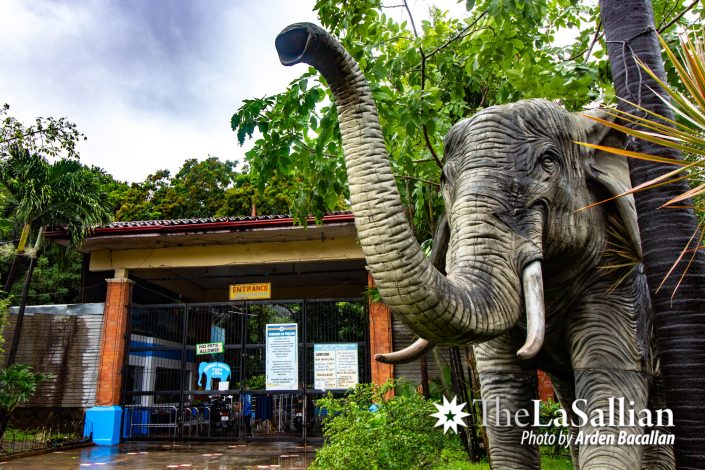Manila Zoo, the mini jungle at the heart of an urban city, is a place shrouded in mystery and stereotypes. It has often been the center of news reports and unwarranted scandals. The LaSallian wades through the enigma surrounding Manila Zoo with the help of Jazz Ong (AB-OCM ‘18), a passionate volunteer for Zoo Crew, the official volunteer group of the zoo.
Welcome to the jungle
It takes less than 15 minutes for a person to walk from DLSU’s hectic hallways to Manila Zoo. The zoo is home to over a thousand individual animals, all of which cohabitate on an expanse of approximately 5.67 hectares of land, and the fact that the zoo is located so close to the heart of Manila’s urban cityscape seems all the more impressive. Its accessibility to the general public is probably one of the main reasons why the zoo reported nearly half a million annual visitors back in 2015.
Aside from the zoo’s location, another reason people flock to Manila Zoo is the variety of wildlife it features. It houses approximately 90 different species of animals, including Maali the Asian elephant and Raffy the lion. Since each animal has its own specific needs, wildlife reserves such as Manila Zoo have the particularly daunting task of providing for them and giving them the means for a happy life. While some believe that zoos mistreat animals and blindly condemn the very idea of them, others like Jazz choose to volunteer and see firsthand how zoo animals are treated.

Beyond the cages
Volunteering at Manila Zoo for over a year helped give Jazz a more rounded outlook at how zoos are run and how animals are treated.
When people visit zoos, they often see animals kept inside cages—giving them the impression that zoos do not give animals natural stimulus that they would have encountered in the wild. Jazz shares that volunteers like her provide enrichment activities to animals every week. These activities are animal-specific and they help nurture zoo animals to behave as if they’re still in their natural habitat. This is Jazz’s favorite thing as a zoo volunteer—staying close to animals as they learn, grow, and develop their characteristics. Moreover, seeing visitors interacting with animals with genuine interest, care, and love keeps Jazz driven in her work as she wants other people to understand animals better.
Aside from tours, educational talks, and animal interaction, zoo volunteers also rescue animals. “One day, I arrived at the zoo and someone had brought in a huge reticulated python,” Jazz shares that she was among those who helped in carrying the huge python to his enclosure. Getting some stray animals—especially the wild ones—protected and rehabilitated is also an instinctive task of zoo workers. Working with such creatures, as Jazz mentions, not only piques her interest in animals, but also gives her a greater sense of duty toward the animals’ welfare. This sense of duty, too, was the one behind her viral video about volunteering in Manila Zoo—reaching hundreds of thousands of people and inciting a sudden surge of new volunteers.
Despite these genuine efforts, zoos and those who work for zoos receive negative press. Jazz believes that this is an issue of misinformation. “For example, PETA launched a ‘Free Maali’ campaign which says that Maali should be moved to a sanctuary overseas. What they don’t know is that Maali is very happy and we can say that based on actual facts and evidence,” she explains. This is supported by the observation that Maali does not show oil secretion near her temples, which is a sign of stress in elephants. On the contrary, Maali is said to usually be seen flapping her ears, which animal behaviorists suggest to be an indicator of comfort and joy.
Dr. David Hone, a writer and palaeontologist, recognizes in his article from The Guardian that the “degree of care and degree of enclosure make the idea of ‘captivity’ (in zoos) fluid and not absolute.” He explains that there are animals—especially those under critical conditions—that need to be kept in zoos “for them to have a quality of life as high or higher than in the wild.”
Think twice
Back in January, the zoo’s operations were put on hold due to the Department of Environment and Natural Resources (DENR) identifying it as a major pollutant of Manila Bay. This accusation has since been debunked, with commercial establishments revealed as the main sources of pollution. Nevertheless, Manila Zoo has remained closed in accordance with the city government’s order of constructing sewer lines. Additionally, plans have also been made toward the rehabilitation and improvement of the other facilities in the zoo in preparation for its eventual reopening.
Jazz urges critics to visit Manila Zoo and to keep an open mind. “Do not form judgements unless you know what you are talking about,” she says as a reminder to all those who were quick to condemn the zoo’s treatment of its animals. “[And] to my fellow Lasallians, I know we are smarter and know better than to just base what we know on other people’s opinions. As people studying in a research-specializing university, I urge you to use that as a tool to find out the truth about issues like this, because fake news is everywhere. I take pride in the fact that DLSU has taught me to be more than someone who can be so easily fooled by that,” she adds.
While there is much to glean from Jazz’s insights, one key takeaway is not just to think, but to objectively analyze and delve deep before you arrive at an opinion. In the case of Manila Zoo, quick assumptions coupled with sensational and irresponsible reporting, especially with the “Free Maali” campaign, cast the zoo in a negative light, undoubtedly affecting lives and livelihoods.
While everyone is entitled to their own opinion, the subject of Manila Zoo has proven once again that people must do adequate research instead of jumping to conclusions.
